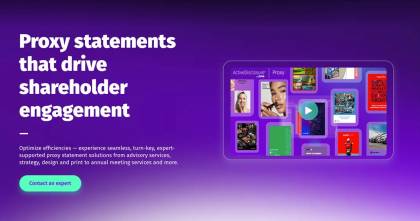The 2025 proxy season is here, and for the third year, virtually all public companies will be required to include pay-versus-performance (PVP) disclosure details. Companies that recently left Emerging Growth Company (EGC) status in the past year may need to include the disclosure for the first time in their next proxy. The impetus behind this requirement ties back to the 2008 financial crisis, and the resultant Dodd-Frank Wall Street Reform and Consumer Protection Act.
The Dodd-Frank Act features more than 400 rules and mandates that increased oversight of financial products. This includes PVP disclosure requirements that raise the bar on transparency by providing investors with consistent, comparable information about the relationship between executive compensation and company performance.
Now businesses must include these details in their proxies, and DFIN is here to help. We have consolidated years of expertise into our 12th annual Guide to Effective Proxies, which enables organizations to benchmark against evolving best practices so they can create proxies that communicate more effectively. But it’s not just our expertise. DFIN clients also count on our collaborative document management software, ActiveDisclosure, to streamline their processes, maximize efficiencies and create proxy statements that drive shareholder engagement. Add it all up and we have great insights into this new requirement.
Here are some things to keep in mind as you get started with your proxy.
Start Early
A big takeaway from years one and two of the PVP disclosure requirement is to start early, because these disclosures, which may seem relatively simple on the surface, require complex calculations as well as new data sets that many businesses have not tracked previously.
DFIN’s expert corporate governance team is always available to review proxy and shareholder materials and can work with your company to create efficiencies and optimize your shareholder engagement throughout the year, especially during annual meetings.
Identify Your iXBRL Experts
These disclosures also require Inline XBRL (iXBRL) tagging, making this the first content in U.S. proxies to require the use of iXBRL, adding additional prep time to the process. As a leader in iXBRL, DFIN is uniquely positioned to support companies in meeting the new iXBRL tagging requirements for Pay Versus Performance disclosures. With built-in iXBRL tagging functionality in our ActiveDisclosure for proxy software, and a team of experts who know precisely how and what to tag, DFIN ensures data is tagged accurately, remains compliant, and is readily accessible for investors seeking clear insights into the alignment between executive compensation and company performance.
Leverage Available Resources
Take advantage of the available resources such as the SEC's Compliance & Disclosure Interpretations (C&DIs). The C&DIs provide clarity on how to interpret and apply the rules while detailing how they must be included in proxy statements or information statements that include executive compensation disclosure. The C&DIs include three key PVP disclosure elements that businesses should pay close attention to. Visual examples of these are included in our Guide to Effective Proxies. These three elements include:
- Pay versus Performance Table: This table provides a comprehensive comparison of executive compensation and company performance over a period of time. Make sure the table includes five years of information on actually paid compensation to the CEO and other named executive officers (NEOs). It should also include metrics such as Total Shareholder Return (TSR), net income, and other performance measures while adhering to the specific format required by the SEC.
- Tabular List: The tabular list includes the most important financial performance measures used by the company when it comes to setting executive compensation for the most recently completed fiscal year. Be sure to include at least three and no more than seven financial performance measures used by the business to link to compensation actually paid to NEOs for the last fiscal year. This can include TSR, revenue growth, operating income, return on equity (ROE), earnings per share (EPS), and earnings before interest, taxes, depreciation, and amortization (EBITDA).
- Pay versus Performance Descriptive Disclosure or Narrative: Businesses should explain the relationship between compensation actually paid to the NEOs and the performance measures disclosed in the Pay versus Performance Table.
To see some examples of these three elements, take a deeper dive into our Guide to Effective Proxies where you can view best-in-class examples on how to report PVP using clear charts that help shareholders quickly understand PVP relationships.
PVP Disclosure Placement
The C&DIs also touch on the placement of the disclosure in the proxy. From our experiences last year, almost all companies placed these new disclosures after, not in, the Compensation Discussion and Analysis (CD&A), which provides information about a company's compensation policies, decisions, and programs, including those for named executive officers (NEOs). In most cases, the disclosures were also included right before or after the pay ratio disclosure. Next, most businesses included one to four graphs to demonstrate the relationships described in the narrative, with three graphs being the most prevalent.
DFIN is Here to Help
DFIN is a great resource when it comes to creating an effective proxy as well as using iXBRL, and we are available to share our expertise and how solutions like ActiveDisclosure can be used as a resource as companies build effective and compliant proxies. Some of the key features we can share include:
- Design: Craft visually compelling proxy statements with customizable page designs and layouts.
- Data Visualization: Incorporate tables, charts, and graphs to make complex data easy to interpret and engaging for stakeholders.
- Microsoft Office Integration: Seamlessly link Excel data, ensuring accuracy and consistency throughout your document.
- Document Changes: Request edits directly through DFIN or use ActiveDisclosure to secure efficient updates and collaborative project support.
At DFIN, you never have to let the proxy season catch you by surprise. Reach out to our team now to get started.

